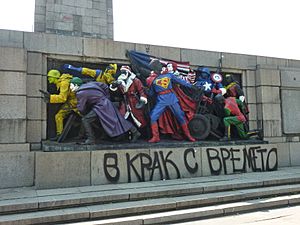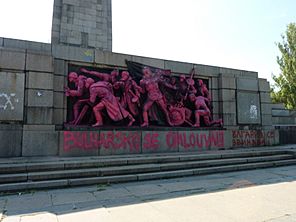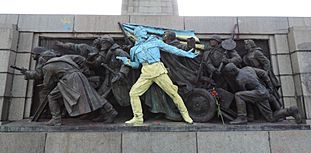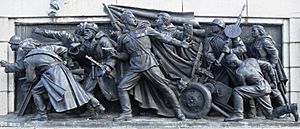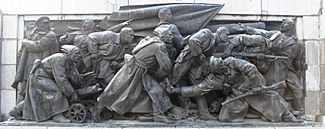Monument to the Soviet Army, Sofia facts for kids
| Паметник на съветската армия | |

The main pedestal, 37 m high
|
|
| Location | Sofia, Bulgaria |
|---|---|
| Height | 37 m |
| Completion date | 1954 |
The Monument to the Soviet Army (Bulgarian: Паметник на Съветската армия, Pametnik na Savetskata armia) is a large statue in Sofia, the capital city of Bulgaria. It stands in a big park, which is a popular spot for young people to meet up. You can find it on Tsar Osvoboditel Boulevard, close to Orlov Most and Sofia University.
The monument shows a soldier from the Soviet Army as a hero, standing with a Bulgarian woman holding her baby and a Bulgarian man. There are also other smaller statues around the main monument. These smaller statues have often been painted by artists to share political messages. The monument was built in 1954. This was to celebrate 10 years since the Soviet Army arrived in Bulgaria, which many Russians saw as a "liberation" during World War II.
Contents
Changing the Monument's Look
Over the years, the monument has become a canvas for artists and activists. They have painted it to express different ideas and feelings.
2011: Pop Art Fun
On June 17, 2011, a group of artists called "Destructive Creation" secretly painted the monument overnight. They "dressed" the Soviet soldiers as famous American pop culture characters. These included Superman, Joker, Robin, Captain America, Ronald McDonald, Santa Claus, Wolverine, The Mask, and Wonder Woman. Underneath, they painted a message that said, "In pace with the times" ("В крак с времето").
The paint was removed a few days later. This event was reported by news channels all over the world. At first, people even compared the unknown artists to the famous street artist Banksy. The painting caused a lot of discussion in Bulgaria about its past links to the Soviet Union and its modern ties to Western countries. Bulgaria's Culture Minister at the time called the painting an act of vandalism.
A short film called In Step with the Time was made about this event. It included interviews with the artists and people from pro-Russian groups in Bulgaria. The film won an award in Poland. The painting showed how Bulgaria was caught between its history with the Soviet Union and the new influences of Western capitalism.
2012: Anonymous Masks
The monument was used again for artistic expression on February 10, 2012. This time, the soldiers were given Anonymous Guy Fawkes masks. Pictures of this were shared in Sofia and across Bulgaria. They were used to invite people to protests against ACTA, a trade agreement, which happened on February 11, 2012, in Bulgaria and other parts of Europe.
Other Changes (2012–2013)
On February 1, 2013, which is Bulgaria's National Day for the Commemoration of the Victims of Communism, three figures on the monument were painted. They were colored white, red, and green, which are the colors of the Bulgarian national flag.
2013: Apology for Prague '68
On August 21, 2013, unknown artists painted the monument pink. This was to mark the anniversary of the 1968 Prague Spring. During the Prague Spring, Soviet-led forces, including some from Bulgaria, entered Czechoslovakia. The monument had messages in both Bulgarian and Czech that said, "Bulgaria apologizes." The pink color was a nod to a similar event in Prague in 1991, when artist David Černý painted a Soviet tank monument pink. Russia officially asked for action against those who painted the monument. Bulgaria's Foreign Minister said that while painting monuments should not happen, it should not cause an "extreme reaction."
2014: "Glory to Ukraine" and "Hands off Ukraine"
On February 23, 2014, the monument was painted again. This time, one soldier's statue and the flag above it were painted in the national colors of Ukraine. The words "Glory to Ukraine" were written in Ukrainian. There was also a message about Russian President Vladimir Putin, calling him "Kaputin" (meaning "broken" in German). This act showed support for the 2014 Ukrainian Revolution. A photo of the painted monument was even featured on Euronews as "Best of the Day."
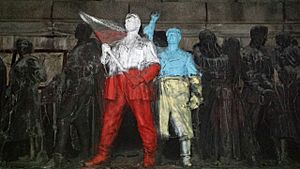
Russia's Ministry of Foreign Affairs expressed anger about this painting. They asked Bulgaria to investigate and fix the monument.
On March 2, the monument was painted again with another message supporting Ukraine. This was after Russian troops entered the Crimean Peninsula. The message said, "Hands off Ukraine" and crossed out the original dedication "for the liberator Soviet Army from the grateful Bulgarian people."
On April 12, one of the statues was painted in the colors of the Polish flag, and another behind it was painted with Ukrainian colors. Underneath, there was a message about the Katyn massacre, a historical event where Polish officers were killed.
2022: Supporting Ukraine Again
The monument was painted in the colors of the Ukrainian flag once more in 2022. This happened after Russian forces attacked Ukraine.
Future of the Monument
Many Bulgarians have different ideas about what should happen to the monument. Some want it to stay where it is, while others believe it should be moved to Bulgaria's Museum of Socialist Art. The park around the monument is a popular gathering place for skaters, ravers, and other groups. It is also the starting point for the yearly Sofia Pride parade.
In 2011, after one of the painting events, some politicians suggested moving the monument. However, there were not enough votes to make that happen at the time.
In August 2023, a final decision was made to move the monument from its current spot to the Museum of Socialist Art. What will happen to the park after the monument is moved is still being decided.
On December 12, 2023, workers began taking apart some of the figures from the monument.
Sculptures


